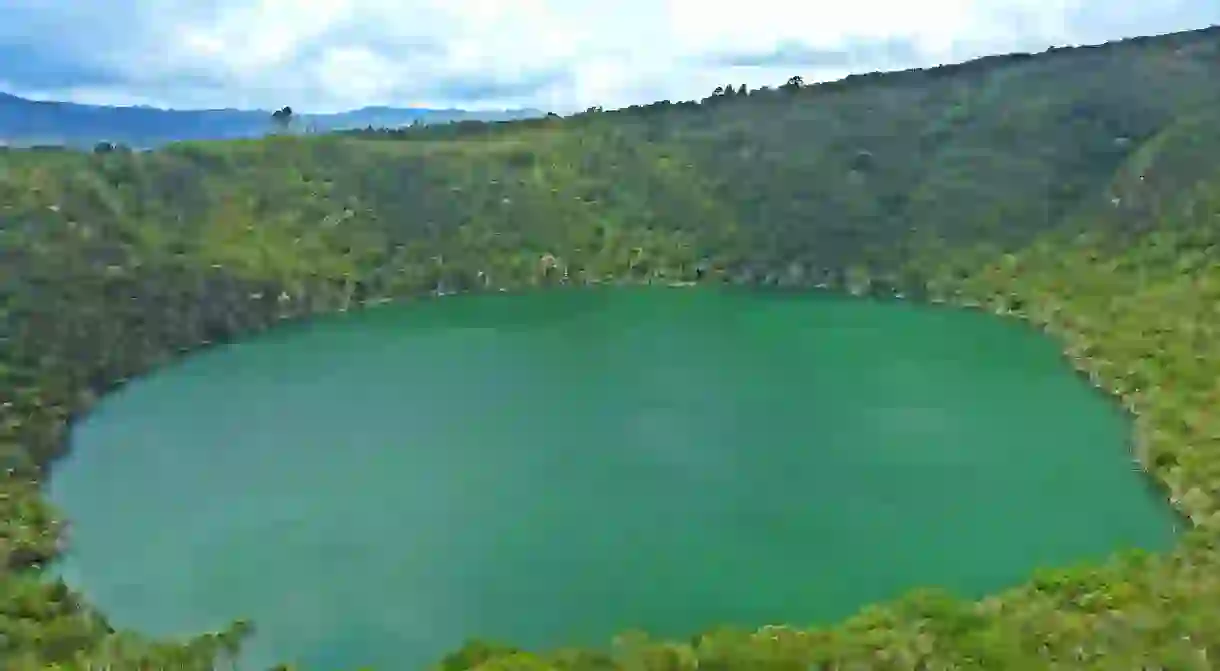The Mystery Behind the Lake of Fool's Gold, Colombia

Colombia‘s small Lake Guatavita northeast of Bogotá is believed to be the origin of the legend of El Dorado. It was a sacred place to the indigenous Muisca people, and their golden offerings led to whisperings of a lost city of treasure that took thousands of men on a quest throughout South America. Guatavita itself has been plundered for hundreds of years, but has never surrendered its golden secret… Here’s everything you need to know.
Background
Guatavita lies around 50km (31 miles) northeast of Bogotá and, at first glance, appear to be little more than a small Andean lake – a beautiful and almost perfectly circular lake admittedly, but not one that immediately stands out as somewhere special with such an important role in history. However, Guatavita is believed by many people to be the place behind the legend of El Dorado.

El Dorado
The legend of El Dorado is one which endured for centuries and inspired expeditions throughout South America: the first complete navigation of the Amazon River by Francisco de Orellana occurred during an expedition in search of a Lost City of Gold, and Sir Walter Raleigh searched the highlands of Guyana for an ancient lake and city which he believed to be the location of the mythical El Dorado. Much of northern South America was mapped during various quests for El Dorado. However, the origins of this highly pervasive and enduring legend can be found at Lake Guatavita.
The Muisca people
Guatavita was a sacred lake for the Muisca people – who, along with the Aztecs, Mayas, and Incas were one of the four advanced civilizations of the Americas – and a ritual which they conducted there is thought to have formed the basis of the El Dorado story. ‘El Dorado‘in Spanish means ‘the Golden One’, which was the name given by the Spanish conquistadors to the Zipa- the ruler of the region then known as Bacatá.
The Zipawas responsible for making a golden offering to the Muisca gods, and one of the sites of these offerings was the sacred lake of Guatavita. He would cover his body with gold dust and then sail to the centre of the round lake on a small barge made of rushes – when he reached the middle of the lake he would dive into the waters, washing the gold off, while others members of the offering party threw gold and silver figures into the lake. The raft ritual is depicted in a famous golden ornament housed in Bogotá’s Gold Museum.
http://instagram.com/p/BRUplxkjmkf/?tagged=museodelorobogota
Discovery of the lake
It is said that the Spanish in the area had become aware of the existence of a sacred lake used for offerings perhaps as early as 1531, but its location was first discovered in 1537 by Gonzalo Jiménez de Quesada – also known as the founder of Bogotá – on an expedition in the eastern Andes. He was seeking gold at the time and came across the source of the stories of ‘El Dorado.’
Finding treasure
The first attempts to plunder the lake of its golden riches were made in 1545, when a plan to drain the lake with a ‘bucket chain’ resulted in a drop of only 3 metres (9.8 feet) in the water level, and gold with a modern value of around US$100,000 was discovered. The most famous effort occurred in 1580, when a Bogotá businessman cut a deep notch – still visible today – in the rim of the lake. The water level was reduced by 20 metres (65.6 feet) and somewhere in the region of US$400,000 worth of gold was found.

The final attempt
When Alexander Von Humboldt visited Guatavita in 1801 he calculated, based on the finding of the efforts of 1580, that the lake might hold as much as US$300 million worth of gold. A final attempt in 1898 reduced the lake to just 1.2 metres (4 feet) of thick mud and slime which hardened in the sun and made an investigation impossible. Just £500 of gold ornaments were found. Since 1965 the lake has been protected, and it seems like its secrets will never be truly understood.
Lake Guatavita today
The true source of the legend of El Dorado will likely never be truly understood: the Spanish invaders have commonly been characterized as ‘gold crazed’ in that period, and it is probable that the legend arose gradually from a variety of similar and competing stories and legends. However, there is much evidence to suggest that the beautiful Lake Guatavita is the principal source of the legend which changed the face of the conquest of South America.













